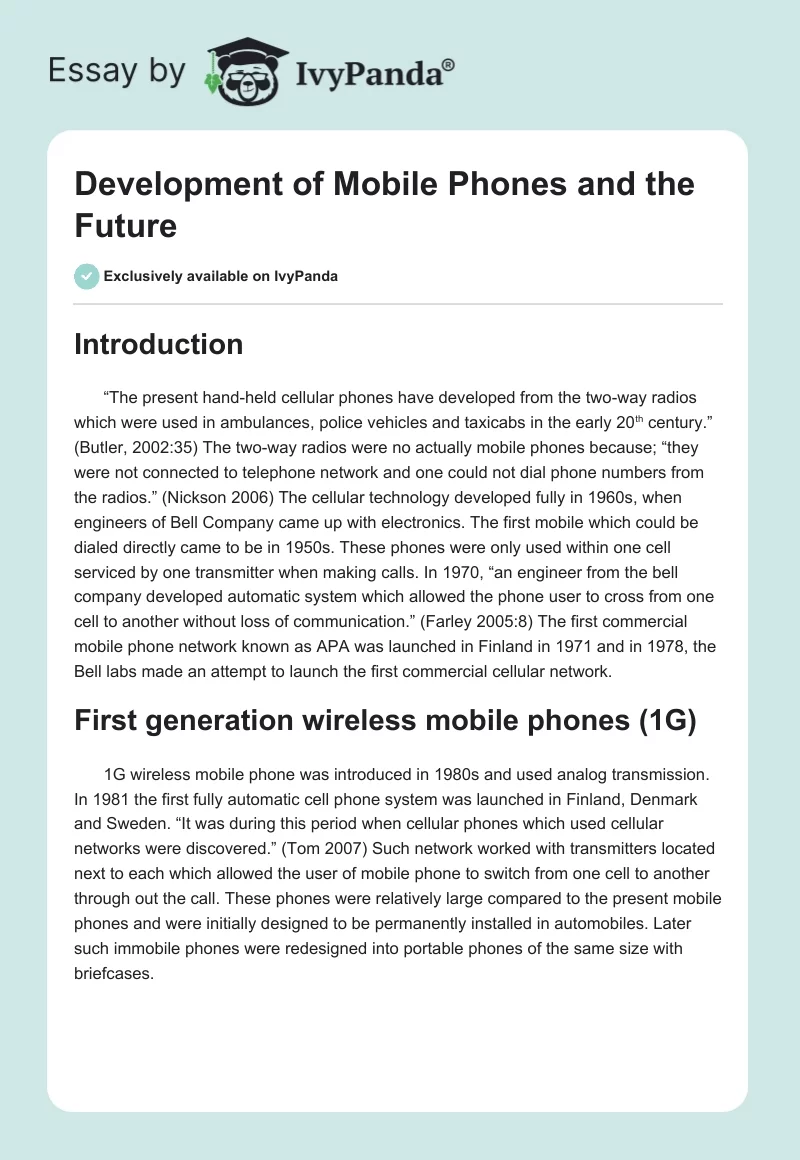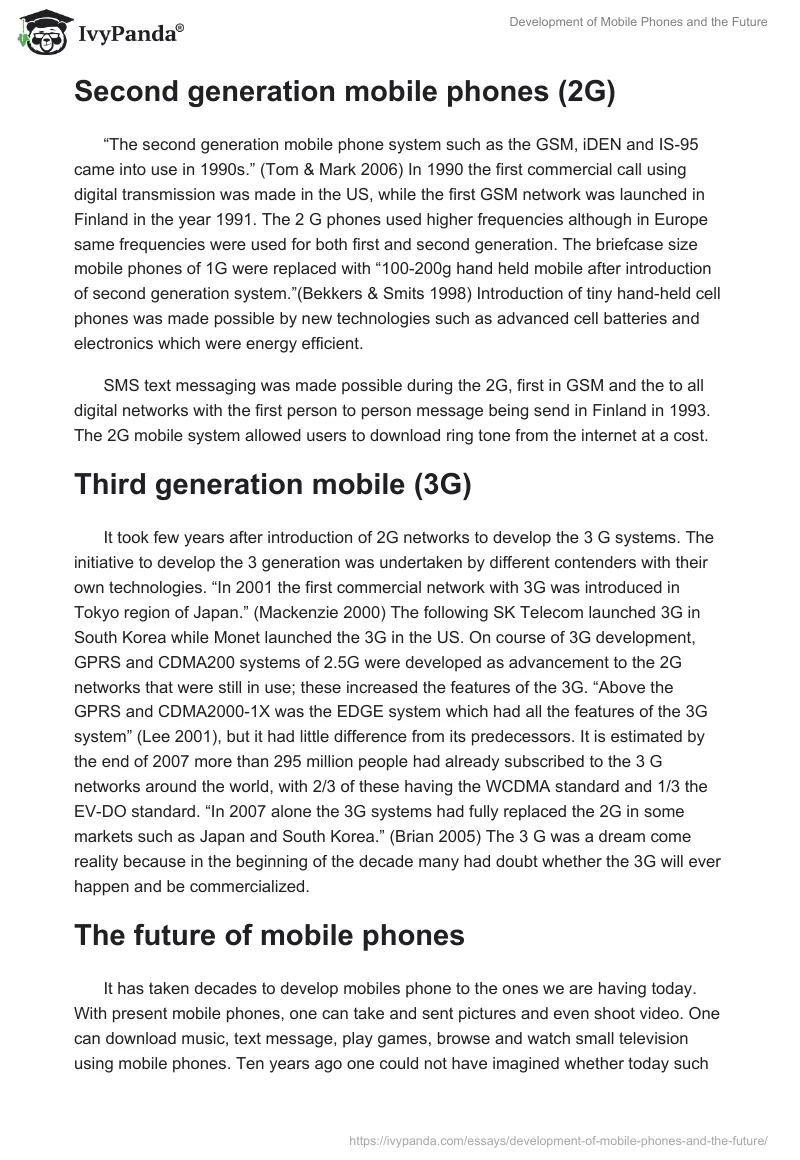Introduction
“The present hand-held cellular phones have developed from the two-way radios which were used in ambulances, police vehicles and taxicabs in the early 20th century.” (Butler, 2002:35) The two-way radios were no actually mobile phones because; “they were not connected to telephone network and one could not dial phone numbers from the radios.” (Nickson 2006)
The cellular technology developed fully in 1960s, when engineers of Bell Company came up with electronics. The first mobile which could be dialed directly came to be in 1950s. These phones were only used within one cell serviced by one transmitter when making calls. In 1970, “an engineer from the bell company developed automatic system which allowed the phone user to cross from one cell to another without loss of communication.” (Farley 2005:8) The first commercial mobile phone network known as APA was launched in Finland in 1971 and in 1978, the Bell labs made an attempt to launch the first commercial cellular network.
First generation wireless mobile phones (1G)
1G wireless mobile phone was introduced in 1980s and used analog transmission. In 1981 the first fully automatic cell phone system was launched in Finland, Denmark and Sweden. “It was during this period when cellular phones which used cellular networks were discovered.” (Tom 2007) Such network worked with transmitters located next to each which allowed the user of mobile phone to switch from one cell to another through out the call. These phones were relatively large compared to the present mobile phones and were initially designed to be permanently installed in automobiles. Later such immobile phones were redesigned into portable phones of the same size with briefcases.
Second generation mobile phones (2G)
“The second generation mobile phone system such as the GSM, iDEN and IS-95 came into use in 1990s.” (Tom & Mark 2006) In 1990 the first commercial call using digital transmission was made in the US, while the first GSM network was launched in Finland in the year 1991. The 2 G phones used higher frequencies although in Europe same frequencies were used for both first and second generation. The briefcase size mobile phones of 1G were replaced with “100-200g hand held mobile after introduction of second generation system.”(Bekkers & Smits 1998) Introduction of tiny hand-held cell phones was made possible by new technologies such as advanced cell batteries and electronics which were energy efficient.
SMS text messaging was made possible during the 2G, first in GSM and the to all digital networks with the first person to person message being send in Finland in 1993. The 2G mobile system allowed users to download ring tone from the internet at a cost.
Third generation mobile (3G)
It took few years after introduction of 2G networks to develop the 3 G systems. The initiative to develop the 3 generation was undertaken by different contenders with their own technologies. “In 2001 the first commercial network with 3G was introduced in Tokyo region of Japan.” (Mackenzie 2000) The following SK Telecom launched 3G in South Korea while Monet launched the 3G in the US. On course of 3G development, GPRS and CDMA200 systems of 2.5G were developed as advancement to the 2G networks that were still in use; these increased the features of the 3G.
“Above the GPRS and CDMA2000-1X was the EDGE system which had all the features of the 3G system” (Lee 2001), but it had little difference from its predecessors. It is estimated by the end of 2007 more than 295 million people had already subscribed to the 3 G networks around the world, with 2/3 of these having the WCDMA standard and 1/3 the EV-DO standard. “In 2007 alone the 3G systems had fully replaced the 2G in some markets such as Japan and South Korea.” (Brian 2005) The 3 G was a dream come reality because in the beginning of the decade many had doubt whether the 3G will ever happen and be commercialized.
The future of mobile phones
It has taken decades to develop mobiles phone to the ones we are having today. With present mobile phones, one can take and sent pictures and even shoot video. One can download music, text message, play games, browse and watch small television using mobile phones. Ten years ago one could not have imagined whether today such phones with such features could be available. The number of people with phones has grown tremendously and it is estimated that more than 3.2 billion people at least have one mobile phone. They have become essential such that its like one can not do without them and everybody loves to use them.
Although the third generation systems have high data transfer rates than other phones, many services are yet to be included in the 3 G phones. When more features will be incorporated in the 3G phones, the world will have one unified phone such that one could use same phone in any country without difficulties. “The 3G is expected to transform cell phones into a multimedia center in the next ten years.” (Andy) The 3 G phones will have ability to access more websites, many people will be able to use internet which will generate a lot of revenue to the internet providers. With this technology it will reach a point where a mobile phone will be equal to a MP3 player or personal computer. We will have tiny, more powerful, cheaper and sensor rich devices in ten years time.
References
- Andy Rubin. The future of mobile.
- Bekkers, R. & Smits, J. (1998) Mobile Telecommunications: Standards, Regulation, and Applications. Boston: Artech House Publishers. 89-100.
- Brian, Marshall. How Cell Phones Work. 2005. Web.
- Butler, M. (2002) Wireless Networks Case Study: Djanogly City Technology College Nottingham. Proceedings of the European Workshop on Mobile and Contextual Learning, the University of Birmingham 34-65.
- Farley, Tom. Mobile Phone History: Phone Warehouse. 2005.
- Lee, W. (2001) Essentials of Wireless Communications, McGraw-Hill: United States of America.22-40.
- Mackenzie, K. Writings on the wall for unsolicited SMS. The Australian. 2000.
- Mark van der Hoek & Tom, Farley. Cell and Sector Terminology, 2006.
- Nickson Chris. The Future of Cell Phones. 2006.
- Tom, Farley (2007) The Cell-Phone Revolution. American heritage of invention & technology New York: American Heritage 22 (3) pp. 8–19.


